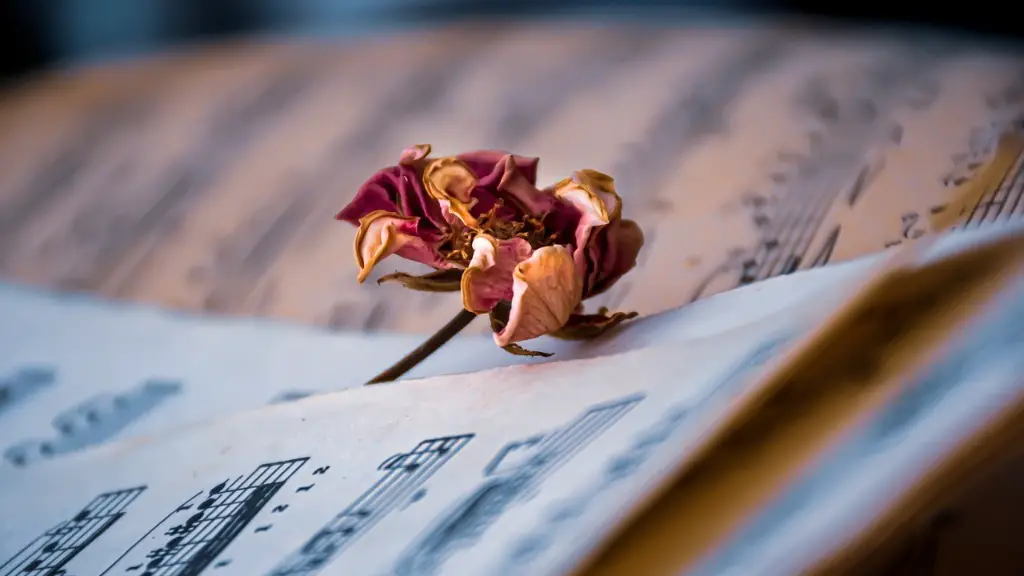Japan has a long and rich history of writing and storytelling that has produced some of the most thought-provoking and poignant poetry in the world. Through its long tradition of written poetry, its influence on contemporary Japanese literature and culture has been felt far and wide. Japanese poetry is marked by a unique aesthetic style, one that stands out from other traditional styles of poetry from around the world.
Many Japanese poems are made up of two different types of verse: waka–a type of poem composed out of five lines, the first and third containing five syllables and the rest containing seven–and haiku–a three-line poem with the first and last lines having five syllables each, and the middle line having seven syllables. Waka and haiku are generally thought to be the two main forms of traditional Japanese poetry.
Writing poetry has been a fundamental aspect of Japanese culture for centuries. It has been used as a way to express emotion and communicate ideas, to create stories and legends, and to share experiences. Even today, poetry is considered an important part of the Japanese culture, and it is often used as a way to celebrate occasions and observances.
One of the most distinctive features of Japanese poetry is its brevity. Japanese poets often use a few simple words and images to invoke powerful emotions and convey complex ideas. Japanese poets also use meter and sound devices to create a rhythm that enhances the feelings of the poem. These sound effects, combined with the use of metaphors, can create a powerful and vivid atmosphere for the reader.
Other common themes in Japanese poetry are nature and the repression of feelings. By expressing the beauty of the natural world, Japanese poets can create imagery that conveys their emotions in a unique and powerful way. By using metaphors and images, Japanese poets can express their feelings without actually stating them directly, allowing them to express their emotions in a more subtle manner. By writing in this way, they can convey meaning, while also preserving their emotions in a poetic form.
Japanese poetry has been an integral part of Japanese literature and culture for hundreds of years, and its influence continues today. Modern poets often take inspiration from traditional Japanese poetry, though they may adapt it in their own way. Although the form of Japanese poetry has changed somewhat over time, its core principles remain the same: to convey emotion, evoke a strong feeling, and create vivid imagery with just a few simple words.
Themes in Japanse Poetry
One of the most common themes in Japanese poetry is the idea of impermanence or “mujo.” The transient nature of life, as well as its inevitable changes and death, can be seen in the verses of Japanese poetry. The concept of mujo has been a significant part of Japanese culture since ancient times and is often used in Japanese poetry to evoke an air of melancholy and the fleeting nature of life.
The theme of love is also a recurrent one in Japanese poetry. Verses are often used to express love and admiration for a loved one, or to mourn the loss of a relationship. By expressing their emotions in this way, poets can create a powerful contrast between the beauty and sadness of love.
Nature is another important theme in Japanese poetry. By utilizing metaphors and images in their verses, Japanese poets can capture the beauty of nature in an emotional, vivid way. This theme has been used in Japanese poetry for centuries, and is often used as a way to evoke feelings of peace, serenity, and comfort.
By utilizing metaphors and poetic images, Japanese poets can express emotions in a powerful yet succinct way. By using the symbols and rhythms of nature, they can evoke strong emotions in the reader and convey powerful messages in just a few short lines.
Japanese Poetry Writing Styles
The style of Japanese poetry varies greatly depending on the type of poetry being written. Haiku and waka are typically written with a very structured approach, while free-verse poetry is often more improvisational. Some poets also incorporate modern elements into their work, creating a more contemporary style of writing.
The structure of traditional Japanese poetry often focuses on rhythm, symbolism, and metaphor. Poets utilize these elements to create powerful images and convey their intended meaning. By using a specific structure to write poetry, Japanese poets are able to evoke a wide range of emotions and ideas in their writing.
Verse forms such as tanka and renga are also often used as part of the traditional writing process in Japanese poetry. In these forms, poets create verses by using a specific set of rules, focusing on topics such as nature or love. By using this structure, Japanese poets can craft clever and meaningful verses that have greater impact on the reader.
Many modern poets incorporate elements of traditional and contemporary writing styles, crafting poems that are both meaningful and thought-provoking. By utilizing both modern and traditional elements, modern poets can create an exciting and fresh style of writing that draws upon the best of both literary styles.
Influence of Japanese Poetry across Cultures
The influence of Japanese poetry has had a significant impact on other cultures across the globe. The concepts of imagery, rhythm, and symbolism that are so prevalent in Japanese poetry are often used in other forms of artistic expression, from music to painting. Many modern poets from around the world take influence from Japanese poetry, often incorporating Japanese elements into their own work.
In addition to its influence on literature and other forms of art, Japanese poetry is also used as a form of meditation, helping people to relax and connect with their inner selves. Haiku, for example, is a form of meditation that focuses on the connection between nature and the self, using imagery and symbolism to evoke a sense of self-reflection. Other forms of Japanese poetry, such as waka, can be used as a tool to deepen one’s understanding of the world, connecting them to the past while also providing insight into the present.
The influence of Japanese poetry can be seen around the world, in literature, art, and even in everyday life. Its impact has been felt across cultures, transcending language barriers and cultural differences to provide insight and understanding. Through its long history, Japanese poetry has become an integral part of world culture, providing a glimpse into the minds and hearts of people across the globe.
Impact of Japanese Poetry on Emotions
Japanese poetry is renowned for its ability to evoke powerful emotions in readers. Through its imagery, symbolism, and rhythm, Japanese poets can evoke a wide range of feelings in their readers, from beauty and awe to sorrow and sadness. By using a combination of poetic imagery and their own feelings, Japanese poets can create a unique emotional experience for their readers.
One of the most powerful aspects of Japanese poetry is its ability to make the reader feel connected to the poem. By presenting themes and emotions in a concise, yet meaningful way, Japanese poets can create vivid images of the emotions and ideas they are trying to convey in their work. This emotional connection is often what distinguishes great poems from mediocre ones.
In addition to evoking strong emotions, Japanese poetry can also be used to help the reader better understand themselves. By expressing their emotions in a poetic form, Japanese poets can help readers gain insight into their own feelings and thoughts. By exploring their emotions and ideas in a poetic form, they can cultivate a deeper understanding of themselves, while also gaining insight into the way that other people think and feel.
Through its images, symbolism, and emotional power, Japanese poetry has had a significant impact on literature and culture around the world. Its influence can still be seen today, as its concepts and themes are utilized in art and literature around the globe. The unique style of Japanese poetry will continue to inspire generations of writers, poets, and readers for years to come.
Analysis of Japanese Poetry
Japanese poetry has become an essential part of both Japanese culture and literature throughout its long history. By studying and analyzing the works of Japan’s greatest poets, one can uncover deeper insights into the culture and society of Japan. Through their use of imagery, symbolism, and emotion, Japanese poets can tell stories about life, love, and the human condition.
The themes of Japanese poetry are often universal, transcending cultural barriers and speaking to the common human experience. By analyzing the works of Japanese poets, one can gain a better understanding of the Japanese culture and how it has shaped their literature. Additionally, it is possible to gain insight into Japanese philosophy, as the themes of Japanese poetry often reflect a distinct thought process and worldview.
By studying the works of Japan’s greatest poets, one can gain a better understanding of the culture of Japan and its many themes. Through their use of symbolism and imagery, these poets can evoke powerful emotions and inspire readers to think more deeply about life and the world around them. By studying the works of Japan’s greatest poets, one can gain insight into their culture, while also uncovering the powerful emotions and ideas that can be found in their works.
Examples of Japanese Poetry
The works of some of Japan’s most famous poets can provide insight into the themes and styles of traditional Japanese poetry. Classic works such as The Tales of Genji by Murasaki Shikibu and The Pillow Book by Sei Shonagon give readers a glimpse into the unique aesthetic of Japanese poetry. In these two works, readers can see how Japanese poets utilize imagery, symbolism, and sound to evoke powerful emotions.
The haikus of Bashō and Buson are also excellent examples of traditional Japanese poetry. By studying the haikus of these two renowned poets, readers can gain an appreciation for the simplicity and emotion of Japanese poetry. Additionally, the haikus of Issa give readers a unique glimpse into the human experience, as his works often focus on the everyday life of ordinary people.
Modern Japanese poetry is often influenced by traditional styles, while adding a contemporary twist. Poets such as Nanao Sakaki and Kōbō Abe often incorporate modern themes, while still utilizing the traditional structures of Japanese poetry. By studying the works of these poets, readers can gain an understanding of both traditional and modern Japanese poetry.
Conclusion
Through its unique aesthetic style and emotional power, Japanese poetry has come to define the country’s culture and aesthetics. By utilizing imagery, symbolism, and sound, Japanese poets can evoke powerful feelings and create vivid, meaningful works of art. Furthermore, the influence of Japanese poetry can still be seen in other cultures around the globe, inspiring writers and poets to create thought-provoking works that explore the themes of life, love, and the human experience.





